wheel FIAT TALENTO 2020 Owner handbook (in English)
[x] Cancel search | Manufacturer: FIAT, Model Year: 2020, Model line: TALENTO, Model: FIAT TALENTO 2020Pages: 236, PDF Size: 4.86 MB
Page 70 of 236
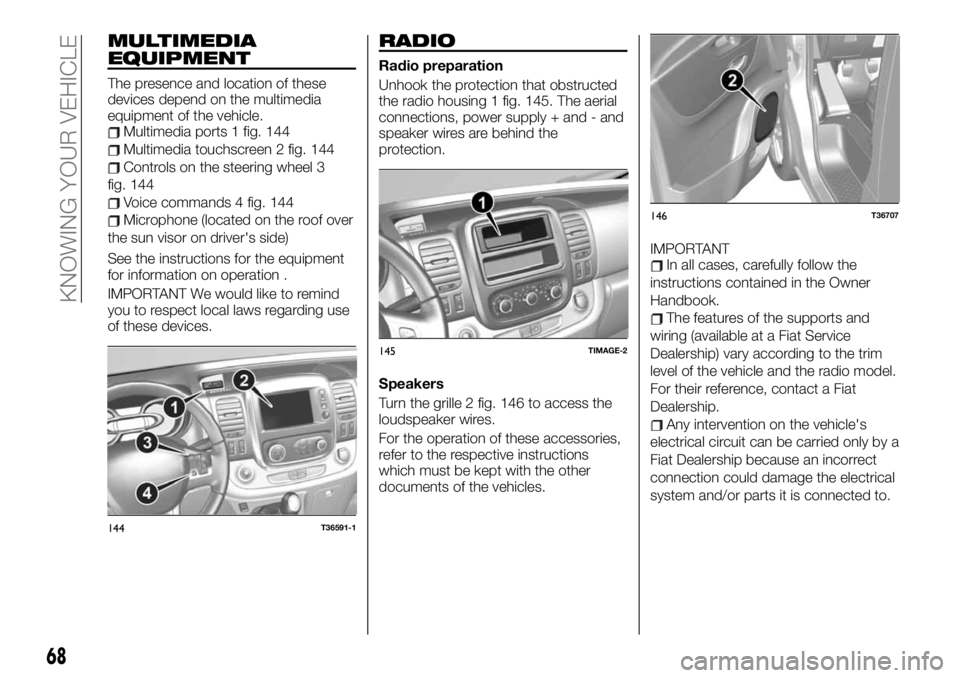
MULTIMEDIA
EQUIPMENT
The presence and location of these
devices depend on the multimedia
equipment of the vehicle.
Multimedia ports 1 fig. 144
Multimedia touchscreen 2 fig. 144
Controls on the steering wheel 3
fig. 144
Voice commands 4 fig. 144
Microphone (located on the roof over
the sun visor on driver's side)
See the instructions for the equipment
for information on operation .
IMPORTANT We would like to remind
you to respect local laws regarding use
of these devices.
RADIO
Radio preparation
Unhook the protection that obstructed
the radio housing 1 fig. 145. The aerial
connections, power supply + and - and
speaker wires are behind the
protection.
Speakers
Turn the grille 2 fig. 146 to access the
loudspeaker wires.
For the operation of these accessories,
refer to the respective instructions
which must be kept with the other
documents of the vehicles.IMPORTANT
In all cases, carefully follow the
instructions contained in the Owner
Handbook.
The features of the supports and
wiring (available at a Fiat Service
Dealership) vary according to the trim
level of the vehicle and the radio model.
For their reference, contact a Fiat
Dealership.
Any intervention on the vehicle's
electrical circuit can be carried only by a
Fiat Dealership because an incorrect
connection could damage the electrical
system and/or parts it is connected to.
144T36591-1
145TIMAGE-2
146T36707
68
KNOWING YOUR VEHICLE
Page 95 of 236
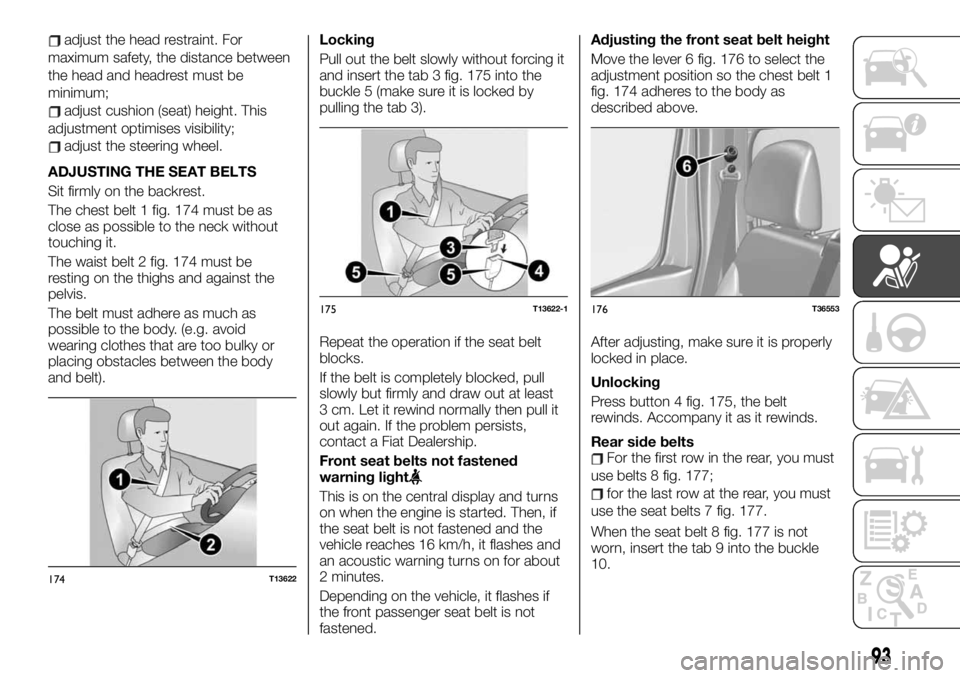
adjust the head restraint. For
maximum safety, the distance between
the head and headrest must be
minimum;
adjust cushion (seat) height. This
adjustment optimises visibility;
adjust the steering wheel.
ADJUSTING THE SEAT BELTS
Sit firmly on the backrest.
The chest belt 1 fig. 174 must be as
close as possible to the neck without
touching it.
The waist belt 2 fig. 174 must be
resting on the thighs and against the
pelvis.
The belt must adhere as much as
possible to the body. (e.g. avoid
wearing clothes that are too bulky or
placing obstacles between the body
and belt).Locking
Pull out the belt slowly without forcing it
and insert the tab 3 fig. 175 into the
buckle 5 (make sure it is locked by
pulling the tab 3).
Repeat the operation if the seat belt
blocks.
If the belt is completely blocked, pull
slowly but firmly and draw out at least
3 cm. Let it rewind normally then pull it
out again. If the problem persists,
contact a Fiat Dealership.
Front seat belts not fastened
warning light
This is on the central display and turns
on when the engine is started. Then, if
the seat belt is not fastened and the
vehicle reaches 16 km/h, it flashes and
an acoustic warning turns on for about
2 minutes.
Depending on the vehicle, it flashes if
the front passenger seat belt is not
fastened.Adjusting the front seat belt height
Move the lever 6 fig. 176 to select the
adjustment position so the chest belt 1
fig. 174 adheres to the body as
described above.
After adjusting, make sure it is properly
locked in place.
Unlocking
Press button 4 fig. 175, the belt
rewinds. Accompany it as it rewinds.
Rear side belts
For the first row in the rear, you must
use belts 8 fig. 177;
for the last row at the rear, you must
use the seat belts 7 fig. 177.
When the seat belt 8 fig. 177 is not
worn, insert the tab 9 into the buckle
10.
174T13622
175T13622-1176T36553
93
Page 98 of 236
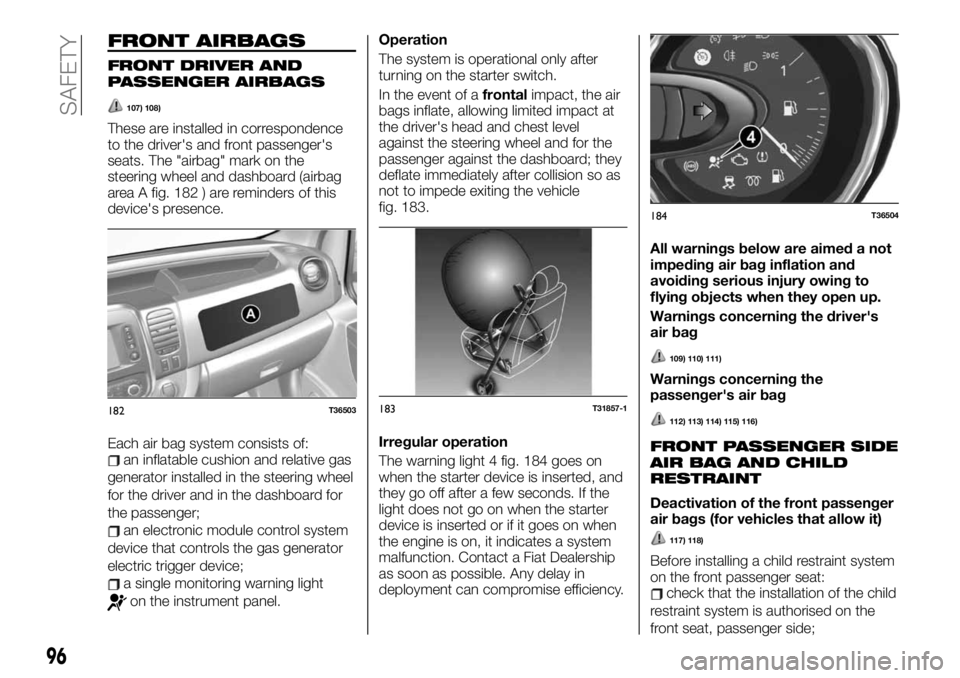
FRONT AIRBAGS
FRONT DRIVER AND
PASSENGER AIRBAGS
107) 108)
These are installed in correspondence
to the driver's and front passenger's
seats. The "airbag" mark on the
steering wheel and dashboard (airbag
area A fig. 182 ) are reminders of this
device's presence.
Each air bag system consists of:
an inflatable cushion and relative gas
generator installed in the steering wheel
for the driver and in the dashboard for
the passenger;
an electronic module control system
device that controls the gas generator
electric trigger device;
a single monitoring warning light
on the instrument panel.Operation
The system is operational only after
turning on the starter switch.
In the event of afrontalimpact, the air
bags inflate, allowing limited impact at
the driver's head and chest level
against the steering wheel and for the
passenger against the dashboard; they
deflate immediately after collision so as
not to impede exiting the vehicle
fig. 183.
Irregular operation
The warning light 4 fig. 184 goes on
when the starter device is inserted, and
they go off after a few seconds. If the
light does not go on when the starter
device is inserted or if it goes on when
the engine is on, it indicates a system
malfunction. Contact a Fiat Dealership
as soon as possible. Any delay in
deployment can compromise efficiency.All warnings below are aimed a not
impeding air bag inflation and
avoiding serious injury owing to
flying objects when they open up.
Warnings concerning the driver's
air bag
109) 110) 111)
Warnings concerning the
passenger's air bag
112) 113) 114) 115) 116)
FRONT PASSENGER SIDE
AIR BAG AND CHILD
RESTRAINT
Deactivation of the front passenger
air bags (for vehicles that allow it)
117) 118)
Before installing a child restraint system
on the front passenger seat:
check that the installation of the child
restraint system is authorised on the
front seat, passenger side;
182T36503183T31857-1
184T36504
96
SAFETY
Page 100 of 236
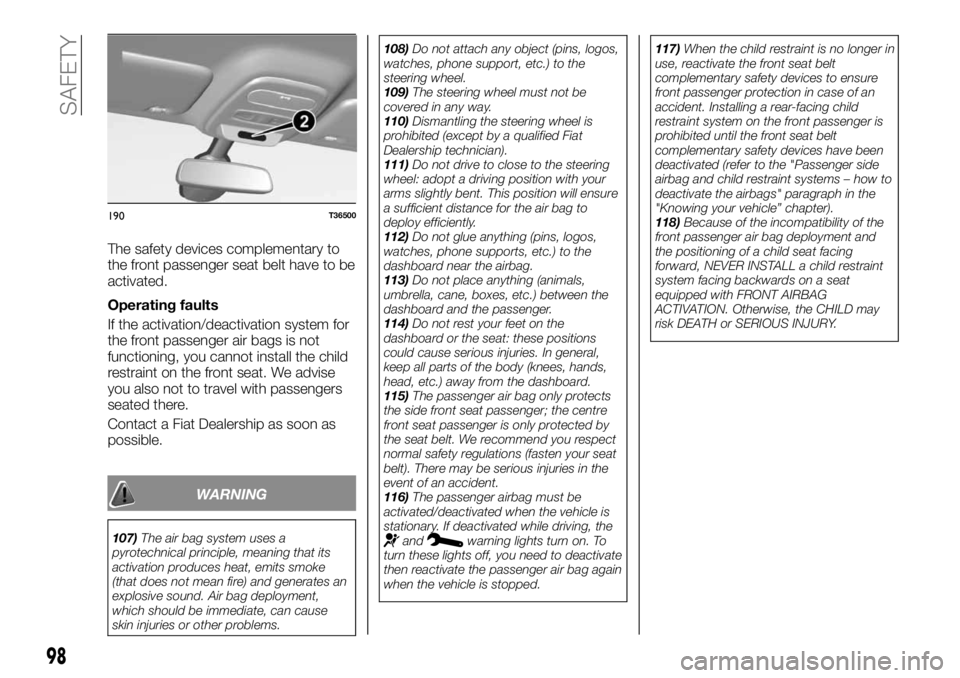
The safety devices complementary to
the front passenger seat belt have to be
activated.
Operating faults
If the activation/deactivation system for
the front passenger air bags is not
functioning, you cannot install the child
restraint on the front seat. We advise
you also not to travel with passengers
seated there.
Contact a Fiat Dealership as soon as
possible.
WARNING
107)The air bag system uses a
pyrotechnical principle, meaning that its
activation produces heat, emits smoke
(that does not mean fire) and generates an
explosive sound. Air bag deployment,
which should be immediate, can cause
skin injuries or other problems.108)Do not attach any object (pins, logos,
watches, phone support, etc.) to the
steering wheel.
109)The steering wheel must not be
covered in any way.
110)Dismantling the steering wheel is
prohibited (except by a qualified Fiat
Dealership technician).
111)Do not drive to close to the steering
wheel: adopt a driving position with your
arms slightly bent. This position will ensure
a sufficient distance for the air bag to
deploy efficiently.
112)Do not glue anything (pins, logos,
watches, phone supports, etc.) to the
dashboard near the airbag.
113)Do not place anything (animals,
umbrella, cane, boxes, etc.) between the
dashboard and the passenger.
114)Do not rest your feet on the
dashboard or the seat: these positions
could cause serious injuries. In general,
keep all parts of the body (knees, hands,
head, etc.) away from the dashboard.
115)The passenger air bag only protects
the side front seat passenger; the centre
front seat passenger is only protected by
the seat belt. We recommend you respect
normal safety regulations (fasten your seat
belt). There may be serious injuries in the
event of an accident.
116)The passenger airbag must be
activated/deactivated when the vehicle is
stationary. If deactivated while driving, theandwarning lights turn on. To
turn these lights off, you need to deactivate
then reactivate the passenger air bag again
when the vehicle is stopped.117)When the child restraint is no longer in
use, reactivate the front seat belt
complementary safety devices to ensure
front passenger protection in case of an
accident. Installing a rear-facing child
restraint system on the front passenger is
prohibited until the front seat belt
complementary safety devices have been
deactivated (refer to the "Passenger side
airbag and child restraint systems – how to
deactivate the airbags" paragraph in the
"Knowing your vehicle” chapter).
118)Because of the incompatibility of the
front passenger air bag deployment and
the positioning of a child seat facing
forward, NEVER INSTALL a child restraint
system facing backwards on a seat
equipped with FRONT AIRBAG
ACTIVATION. Otherwise, the CHILD may
risk DEATH or SERIOUS INJURY.
190T36500
98
SAFETY
Page 128 of 236
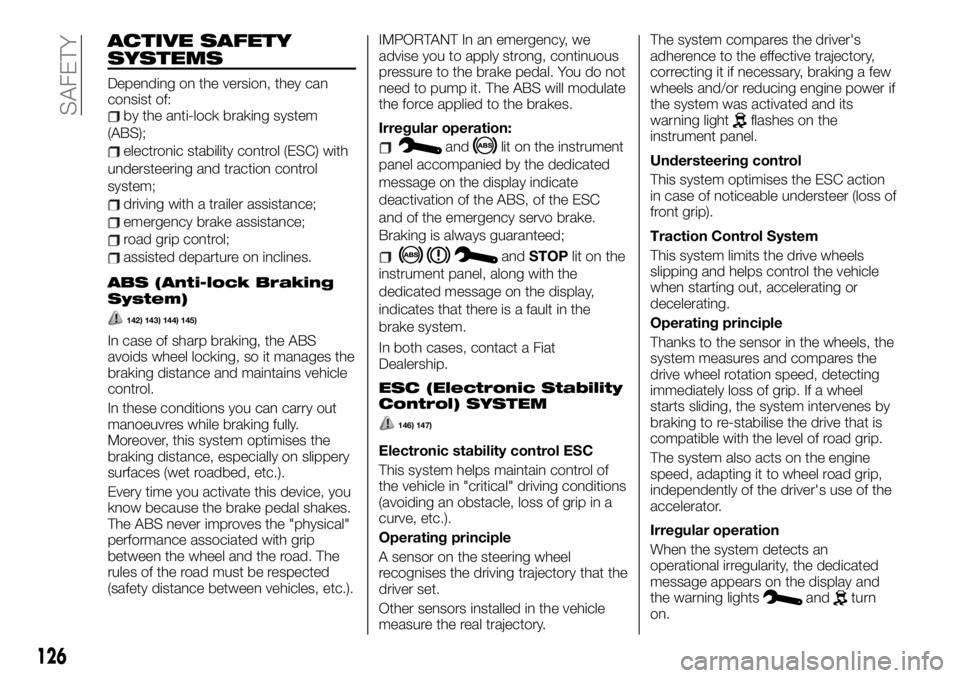
ACTIVE SAFETY
SYSTEMS
Depending on the version, they can
consist of:
by the anti-lock braking system
(ABS);
electronic stability control (ESC) with
understeering and traction control
system;
driving with a trailer assistance;
emergency brake assistance;
road grip control;
assisted departure on inclines.
ABS (Anti-lock Braking
System)
142) 143) 144) 145)
In case of sharp braking, the ABS
avoids wheel locking, so it manages the
braking distance and maintains vehicle
control.
In these conditions you can carry out
manoeuvres while braking fully.
Moreover, this system optimises the
braking distance, especially on slippery
surfaces (wet roadbed, etc.).
Every time you activate this device, you
know because the brake pedal shakes.
The ABS never improves the "physical"
performance associated with grip
between the wheel and the road. The
rules of the road must be respected
(safety distance between vehicles, etc.).IMPORTANT In an emergency, we
advise you to apply strong, continuous
pressure to the brake pedal. You do not
need to pump it. The ABS will modulate
the force applied to the brakes.
Irregular operation:
andlit on the instrument
panel accompanied by the dedicated
message on the display indicate
deactivation of the ABS, of the ESC
and of the emergency servo brake.
Braking is always guaranteed;
andSTOPlit on the
instrument panel, along with the
dedicated message on the display,
indicates that there is a fault in the
brake system.
In both cases, contact a Fiat
Dealership.
ESC (Electronic Stability
Control) SYSTEM
146) 147)
Electronic stability control ESC
This system helps maintain control of
the vehicle in "critical" driving conditions
(avoiding an obstacle, loss of grip in a
curve, etc.).
Operating principle
A sensor on the steering wheel
recognises the driving trajectory that the
driver set.
Other sensors installed in the vehicle
measure the real trajectory.The system compares the driver's
adherence to the effective trajectory,
correcting it if necessary, braking a few
wheels and/or reducing engine power if
the system was activated and its
warning light
flashes on the
instrument panel.
Understeering control
This system optimises the ESC action
in case of noticeable understeer (loss of
front grip).
Traction Control System
This system limits the drive wheels
slipping and helps control the vehicle
when starting out, accelerating or
decelerating.
Operating principle
Thanks to the sensor in the wheels, the
system measures and compares the
drive wheel rotation speed, detecting
immediately loss of grip. If a wheel
starts sliding, the system intervenes by
braking to re-stabilise the drive that is
compatible with the level of road grip.
The system also acts on the engine
speed, adapting it to wheel road grip,
independently of the driver's use of the
accelerator.
Irregular operation
When the system detects an
operational irregularity, the dedicated
message appears on the display and
the warning lights
andturn
on.
126
SAFETY
Page 129 of 236
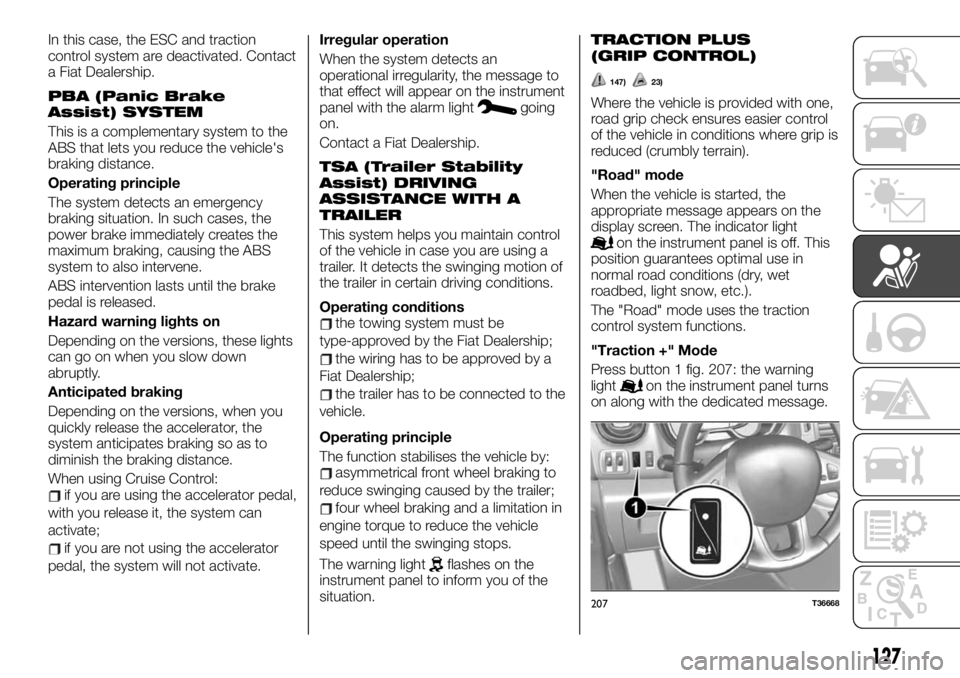
In this case, the ESC and traction
control system are deactivated. Contact
a Fiat Dealership.
PBA (Panic Brake
Assist) SYSTEM
This is a complementary system to the
ABS that lets you reduce the vehicle's
braking distance.
Operating principle
The system detects an emergency
braking situation. In such cases, the
power brake immediately creates the
maximum braking, causing the ABS
system to also intervene.
ABS intervention lasts until the brake
pedal is released.
Hazard warning lights on
Depending on the versions, these lights
can go on when you slow down
abruptly.
Anticipated braking
Depending on the versions, when you
quickly release the accelerator, the
system anticipates braking so as to
diminish the braking distance.
When using Cruise Control:
if you are using the accelerator pedal,
with you release it, the system can
activate;
if you are not using the accelerator
pedal, the system will not activate.Irregular operation
When the system detects an
operational irregularity, the message to
that effect will appear on the instrument
panel with the alarm light
going
on.
Contact a Fiat Dealership.
TSA (Trailer Stability
Assist) DRIVING
ASSISTANCE WITH A
TRAILER
This system helps you maintain control
of the vehicle in case you are using a
trailer. It detects the swinging motion of
the trailer in certain driving conditions.
Operating conditions
the towing system must be
type-approved by the Fiat Dealership;
the wiring has to be approved by a
Fiat Dealership;
the trailer has to be connected to the
vehicle.
Operating principle
The function stabilises the vehicle by:
asymmetrical front wheel braking to
reduce swinging caused by the trailer;
four wheel braking and a limitation in
engine torque to reduce the vehicle
speed until the swinging stops.
The warning light
flashes on the
instrument panel to inform you of the
situation.
TRACTION PLUS
(GRIP CONTROL)
147) 23)
Where the vehicle is provided with one,
road grip check ensures easier control
of the vehicle in conditions where grip is
reduced (crumbly terrain).
"Road" mode
When the vehicle is started, the
appropriate message appears on the
display screen. The indicator light
on the instrument panel is off. This
position guarantees optimal use in
normal road conditions (dry, wet
roadbed, light snow, etc.).
The "Road" mode uses the traction
control system functions.
"Traction +" Mode
Press button 1 fig. 207: the warning
light
on the instrument panel turns
on along with the dedicated message.
207T36668
127
Page 130 of 236
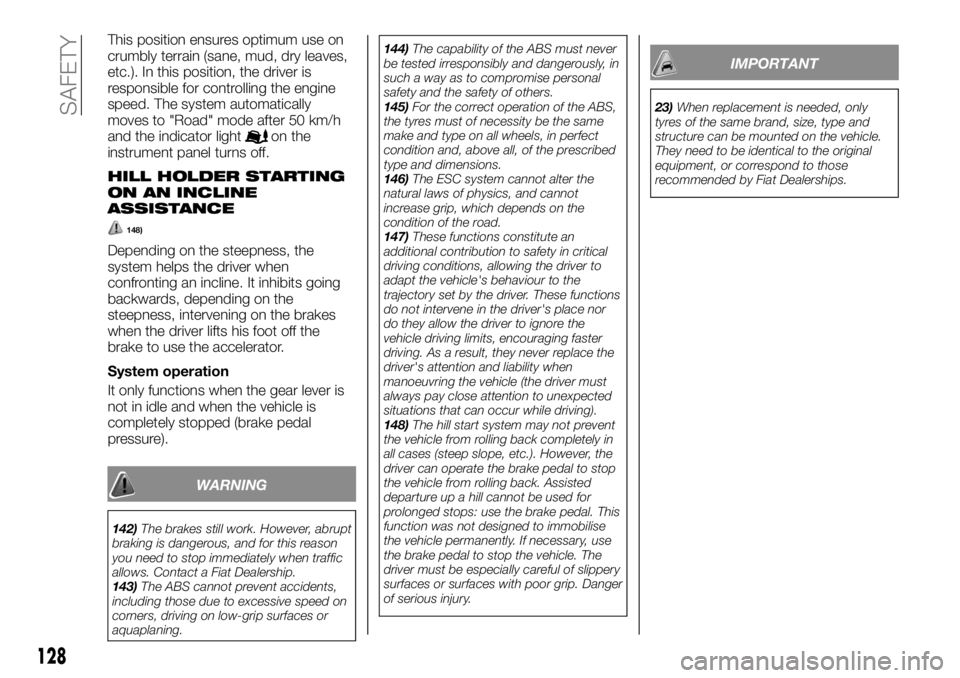
This position ensures optimum use on
crumbly terrain (sane, mud, dry leaves,
etc.). In this position, the driver is
responsible for controlling the engine
speed. The system automatically
moves to "Road" mode after 50 km/h
and the indicator light
on the
instrument panel turns off.
HILL HOLDER STARTING
ON AN INCLINE
ASSISTANCE
148)
Depending on the steepness, the
system helps the driver when
confronting an incline. It inhibits going
backwards, depending on the
steepness, intervening on the brakes
when the driver lifts his foot off the
brake to use the accelerator.
System operation
It only functions when the gear lever is
not in idle and when the vehicle is
completely stopped (brake pedal
pressure).
WARNING
142)The brakes still work. However, abrupt
braking is dangerous, and for this reason
you need to stop immediately when traffic
allows. Contact a Fiat Dealership.
143)The ABS cannot prevent accidents,
including those due to excessive speed on
corners, driving on low-grip surfaces or
aquaplaning.144)The capability of the ABS must never
be tested irresponsibly and dangerously, in
such a way as to compromise personal
safety and the safety of others.
145)For the correct operation of the ABS,
the tyres must of necessity be the same
make and type on all wheels, in perfect
condition and, above all, of the prescribed
type and dimensions.
146)The ESC system cannot alter the
natural laws of physics, and cannot
increase grip, which depends on the
condition of the road.
147)These functions constitute an
additional contribution to safety in critical
driving conditions, allowing the driver to
adapt the vehicle's behaviour to the
trajectory set by the driver. These functions
do not intervene in the driver's place nor
do they allow the driver to ignore the
vehicle driving limits, encouraging faster
driving. As a result, they never replace the
driver's attention and liability when
manoeuvring the vehicle (the driver must
always pay close attention to unexpected
situations that can occur while driving).
148)The hill start system may not prevent
the vehicle from rolling back completely in
all cases (steep slope, etc.). However, the
driver can operate the brake pedal to stop
the vehicle from rolling back. Assisted
departure up a hill cannot be used for
prolonged stops: use the brake pedal. This
function was not designed to immobilise
the vehicle permanently. If necessary, use
the brake pedal to stop the vehicle. The
driver must be especially careful of slippery
surfaces or surfaces with poor grip. Danger
of serious injury.
IMPORTANT
23)When replacement is needed, only
tyres of the same brand, size, type and
structure can be mounted on the vehicle.
They need to be identical to the original
equipment, or correspond to those
recommended by Fiat Dealerships.
128
SAFETY
Page 131 of 236
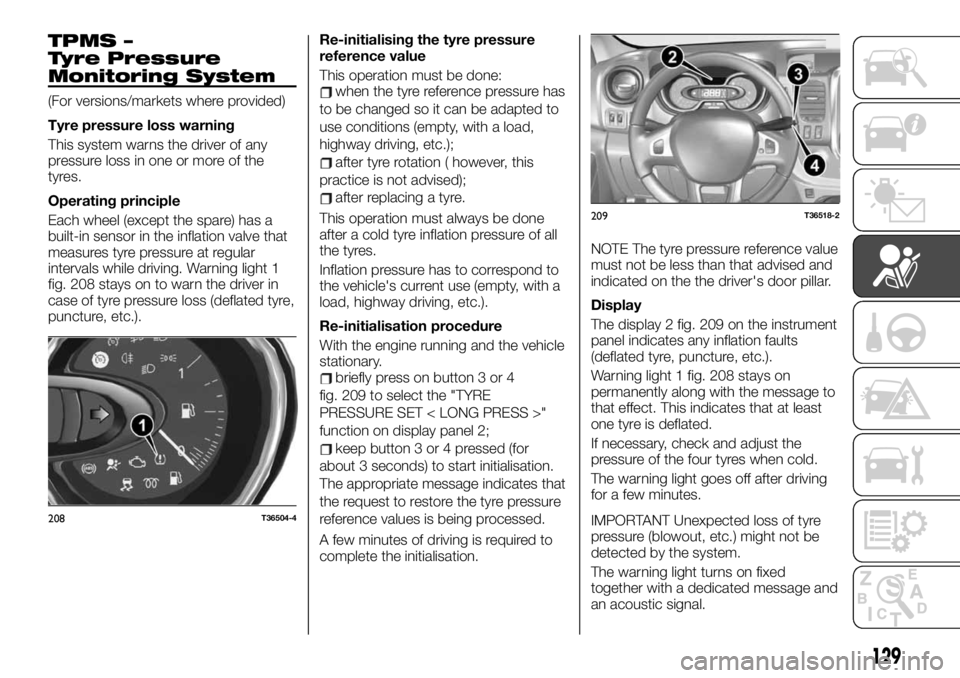
TPMS –
Tyre Pressure
Monitoring System
(For versions/markets where provided)
Tyre pressure loss warning
This system warns the driver of any
pressure loss in one or more of the
tyres.
Operating principle
Each wheel (except the spare) has a
built-in sensor in the inflation valve that
measures tyre pressure at regular
intervals while driving. Warning light 1
fig. 208 stays on to warn the driver in
case of tyre pressure loss (deflated tyre,
puncture, etc.).Re-initialising the tyre pressure
reference value
This operation must be done:when the tyre reference pressure has
to be changed so it can be adapted to
use conditions (empty, with a load,
highway driving, etc.);
after tyre rotation ( however, this
practice is not advised);
after replacing a tyre.
This operation must always be done
after a cold tyre inflation pressure of all
the tyres.
Inflation pressure has to correspond to
the vehicle's current use (empty, with a
load, highway driving, etc.).
Re-initialisation procedure
With the engine running and the vehicle
stationary.
briefly press on button 3 or 4
fig. 209 to select the "TYRE
PRESSURE SET < LONG PRESS >"
function on display panel 2;
keep button 3 or 4 pressed (for
about 3 seconds) to start initialisation.
The appropriate message indicates that
the request to restore the tyre pressure
reference values is being processed.
A few minutes of driving is required to
complete the initialisation.NOTE The tyre pressure reference value
must not be less than that advised and
indicated on the the driver's door pillar.
Display
The display 2 fig. 209 on the instrument
panel indicates any inflation faults
(deflated tyre, puncture, etc.).
Warning light 1 fig. 208 stays on
permanently along with the message to
that effect. This indicates that at least
one tyre is deflated.
If necessary, check and adjust the
pressure of the four tyres when cold.
The warning light goes off after driving
for a few minutes.
IMPORTANT Unexpected loss of tyre
pressure (blowout, etc.) might not be
detected by the system.
The warning light turns on fixed
together with a dedicated message and
an acoustic signal.
208T36504-4
209T36518-2
129
Page 132 of 236
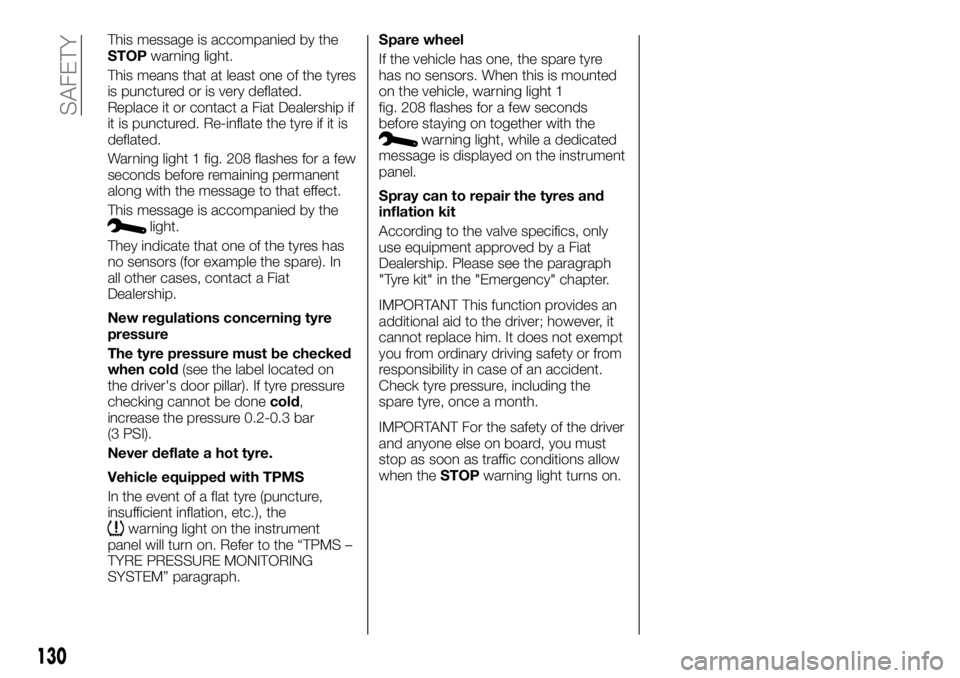
This message is accompanied by the
STOPwarning light.
This means that at least one of the tyres
is punctured or is very deflated.
Replace it or contact a Fiat Dealership if
it is punctured. Re-inflate the tyre if it is
deflated.
Warning light 1 fig. 208 flashes for a few
seconds before remaining permanent
along with the message to that effect.
This message is accompanied by the
light.
They indicate that one of the tyres has
no sensors (for example the spare). In
all other cases, contact a Fiat
Dealership.
New regulations concerning tyre
pressure
The tyre pressure must be checked
when cold(see the label located on
the driver's door pillar). If tyre pressure
checking cannot be donecold,
increase the pressure 0.2-0.3 bar
(3 PSI).
Never deflate a hot tyre.
Vehicle equipped with TPMS
In the event of a flat tyre (puncture,
insufficient inflation, etc.), the
warning light on the instrument
panel will turn on. Refer to the “TPMS –
TYRE PRESSURE MONITORING
SYSTEM” paragraph.Spare wheel
If the vehicle has one, the spare tyre
has no sensors. When this is mounted
on the vehicle, warning light 1
fig. 208 flashes for a few seconds
before staying on together with the
warning light, while a dedicated
message is displayed on the instrument
panel.
Spray can to repair the tyres and
inflation kit
According to the valve specifics, only
use equipment approved by a Fiat
Dealership. Please see the paragraph
"Tyre kit" in the "Emergency" chapter.
IMPORTANT This function provides an
additional aid to the driver; however, it
cannot replace him. It does not exempt
you from ordinary driving safety or from
responsibility in case of an accident.
Check tyre pressure, including the
spare tyre, once a month.
IMPORTANT For the safety of the driver
and anyone else on board, you must
stop as soon as traffic conditions allow
when theSTOPwarning light turns on.
130
SAFETY
Page 135 of 236
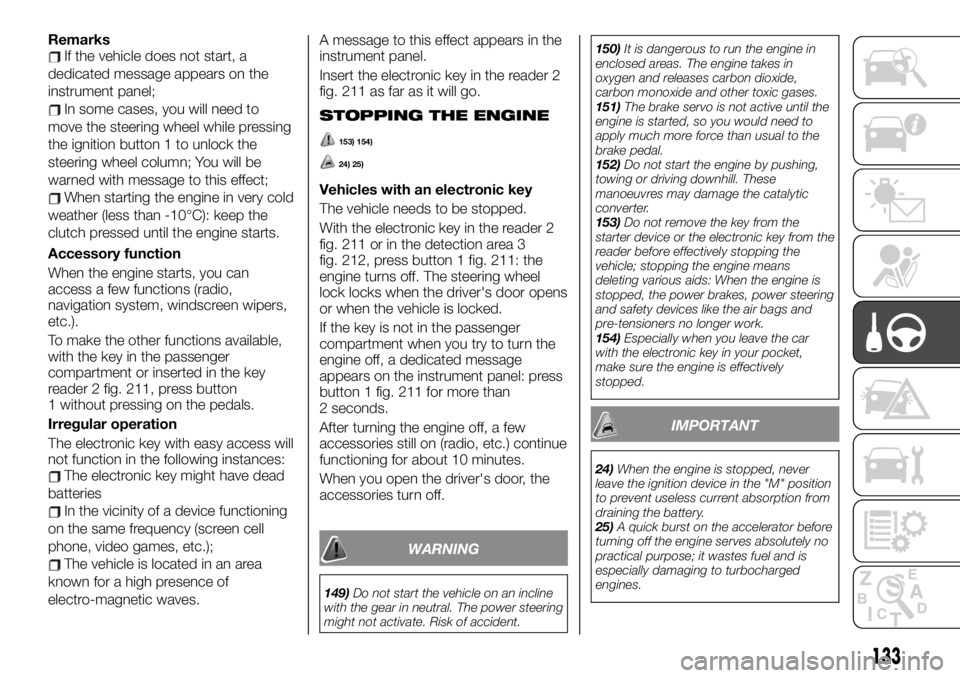
RemarksIf the vehicle does not start, a
dedicated message appears on the
instrument panel;
In some cases, you will need to
move the steering wheel while pressing
the ignition button 1 to unlock the
steering wheel column; You will be
warned with message to this effect;
When starting the engine in very cold
weather (less than -10°C): keep the
clutch pressed until the engine starts.
Accessory function
When the engine starts, you can
access a few functions (radio,
navigation system, windscreen wipers,
etc.).
To make the other functions available,
with the key in the passenger
compartment or inserted in the key
reader 2 fig. 211, press button
1 without pressing on the pedals.
Irregular operation
The electronic key with easy access will
not function in the following instances:
The electronic key might have dead
batteries
In the vicinity of a device functioning
on the same frequency (screen cell
phone, video games, etc.);
The vehicle is located in an area
known for a high presence of
electro-magnetic waves.A message to this effect appears in the
instrument panel.
Insert the electronic key in the reader 2
fig. 211 as far as it will go.
STOPPING THE ENGINE
153) 154)
24) 25)
Vehicles with an electronic key
The vehicle needs to be stopped.
With the electronic key in the reader 2
fig. 211 or in the detection area 3
fig. 212, press button 1 fig. 211: the
engine turns off. The steering wheel
lock locks when the driver's door opens
or when the vehicle is locked.
If the key is not in the passenger
compartment when you try to turn the
engine off, a dedicated message
appears on the instrument panel: press
button 1 fig. 211 for more than
2 seconds.
After turning the engine off, a few
accessories still on (radio, etc.) continue
functioning for about 10 minutes.
When you open the driver's door, the
accessories turn off.
WARNING
149)Do not start the vehicle on an incline
with the gear in neutral. The power steering
might not activate. Risk of accident.150)It is dangerous to run the engine in
enclosed areas. The engine takes in
oxygen and releases carbon dioxide,
carbon monoxide and other toxic gases.
151)The brake servo is not active until the
engine is started, so you would need to
apply much more force than usual to the
brake pedal.
152)Do not start the engine by pushing,
towing or driving downhill. These
manoeuvres may damage the catalytic
converter.
153)Do not remove the key from the
starter device or the electronic key from the
reader before effectively stopping the
vehicle; stopping the engine means
deleting various aids: When the engine is
stopped, the power brakes, power steering
and safety devices like the air bags and
pre-tensioners no longer work.
154)Especially when you leave the car
with the electronic key in your pocket,
make sure the engine is effectively
stopped.
IMPORTANT
24)When the engine is stopped, never
leave the ignition device in the "M" position
to prevent useless current absorption from
draining the battery.
25)A quick burst on the accelerator before
turning off the engine serves absolutely no
practical purpose; it wastes fuel and is
especially damaging to turbocharged
engines.
133